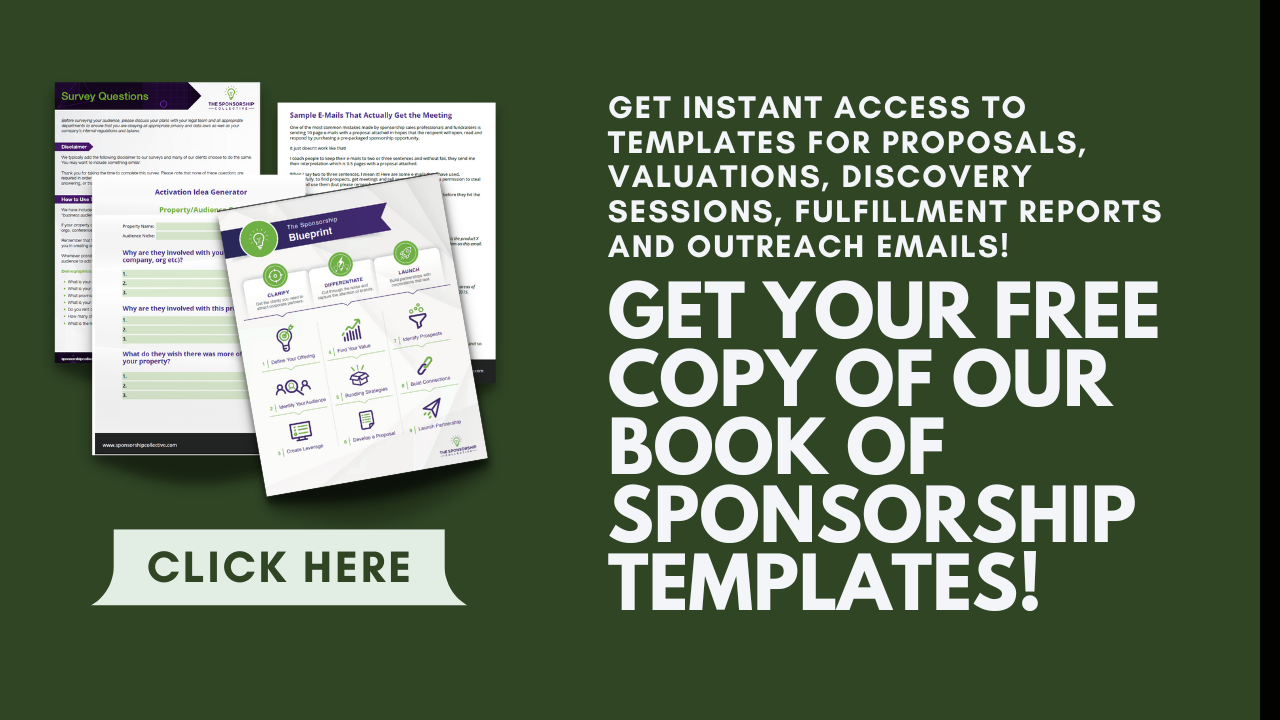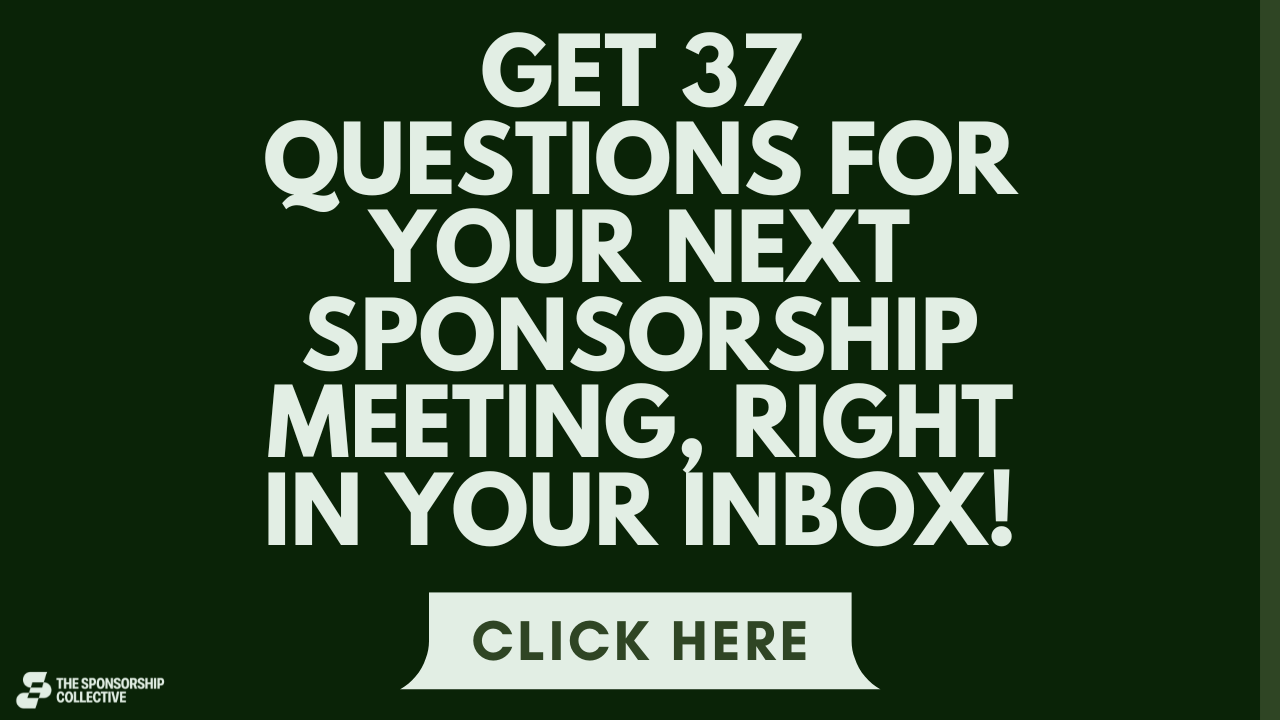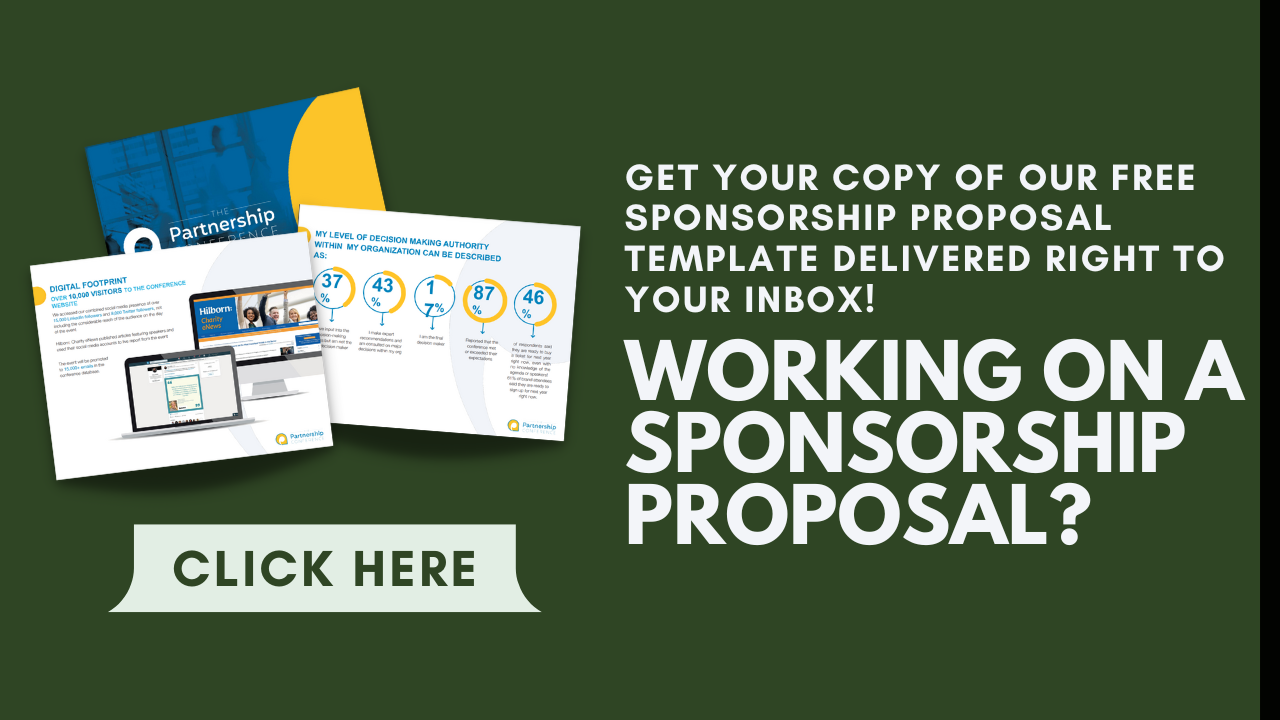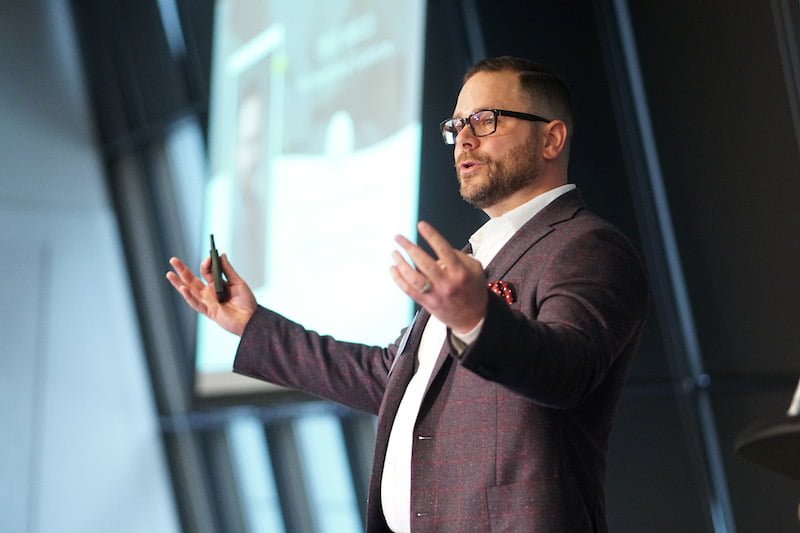If you know me from this blog, then you know that the bane of my existence as someone who assists sponsorship seekers is the old gold, silver, and bronze sponsorship package. It’s just not helpful.
Yet so many more times–more than I can count, really–I’ve gotten the same question from sponsorship seekers.
“Chris, if gold, silver, and bronze tiered sponsorship levels are so bad, then why do they use it?”
The “they” in question can refer to anyone, but it’s usually a wildly successful sponsorship property.
I feel like I’m asked this question in the hopes of being stumped by it, but I’m not. And no matter how many times I get the question, it doesn’t change my mind about stock sponsorship levels.
If anything, it makes me want to double down even further and show you that there’s a better way to approach sponsorship. Check it out.
A Story About the Shortcomings of Stock Sponsorship Packages
Part of the reason I rally against gold, silver, and bronze sponsorship packages so vehemently is that I once experienced the detriments of stock sponsorship levels myself.
Granted, this was way back in 2008, so a lot of time has passed since then (well over 10 years!) and I’ve accumulated a lot of sponsorship knowledge and since shared it with sponsorship seekers all over the world.
Let me tell you the story.
So, like I said, this was in 2008. Back at that point, I hadn’t started the Sponsorship Collective. Rather, I was a sponsorship seeker just like you, but one who did sponsorship professionally.
I had a long-term sponsor–or, shall I say, my company had a long-term sponsor. I was about to have a conversation with them at their office.
As I entered the building and made my way to the office, I noticed something peculiar. There was a stream of people leaving the building with boxes full of personal belongings. You know, like how someone does when they’re being fired.
But there was no way, I thought. That many people couldn’t be getting fired all at once.
It was strange, but I decided to ignore it. I had a meeting, and I fully intended on being punctual.
So I arrived at my sponsor’s office and sat down to talk to them. This was a sales meeting, and I intended–on behalf of my boss and my company–to ask the sponsor for money just as my company had done many times in the past.
This wasn’t a small sponsorship deal either, but a sizable six-figure deal.
We exchanged pleasantries and then I launched into my sales schtick. My sponsor politely listened, and then when I was finished, told me about how yes indeed, he had just laid off 80 percent of his team.
So that’s why I saw so many people with boxes full of personal belongings. They were indeed being fired, and fired in droves, at that.
Unsurprisingly, my sponsor told me that there’s no way he can be part of my next event, which is understandable. If the meeting had ended right then and there, I wouldn’t have begrudged him at all.
But he wasn’t finished. Not quite.

My sponsor also told me, “Besides, we have to be the gold-level sponsor at a local hospital gala coming up, because in exchange for that, they’re going to purchase five years’ worth of X-ray machines from us.”
I could see where my sponsor needed the money, considering all the layoffs, but I couldn’t help but be taken aback.
He clearly did have some money because he was funneling it into another sponsor. He just didn’t want to spend it on my company.
Compared to the other sponsor, which was offering him gold-level perks, I wasn’t doing that because my company wasn’t about stock sponsorship packages. Thus, we looked like the less appealing option.
My sponsor wanted the acclaim of being a gold-level sponsor at the gala. His company’s name would appear on all the signage as a gold-level sponsor. It made him look good, especially to outsiders who might want to do business with him.
The hospital got five years of equipment too, so it looks like a win-win, right?
I wouldn’t go that far at all. I would say the hospital succeeded in this case not because of a gold, silver, and bronze sponsorship package but in spite of it.
Why Bigger Companies Can Get Away with Stock Sponsorship Packages But Smaller Ones Can’t
Going through that experience with my sponsor was confusing and humbling, which is why it’s stayed with me after all these years.
Now, you might think my story from the last section just proves your point. Here’s an example of another bigger company–a hospital, in this case–successfully using gold, silver, and bronze sponsorship tiers.
Surely, it will work for you as well, right?
Nope, wrong. And here’s why.
A sponsorship seeker such as this hospital with significant leverage doesn’t have to worry too much about the assets they’re offering to their prospects. Should they worry? Yes, definitely, but they can get away with not doing so.
The reason? These companies have other things of value outside of the sponsorship package that a prospect finds appealing. Thus, a prospect is willing to look beyond the rather lackluster stock sponsorship package because there’s other value in the offer.
Then there’s a smaller company like yours. I’m not trying to knock your company at all; far from it. Please don’t take it the wrong way, but I do need to prove a point.
Compared to these companies with the leverage and the size and value, you have less of it all. So when a bigger company comes in and offers primarily logos on stuff, it’s perceived as okay. When you do it, you never hear back from your prospects.
It’s not your fault at all if you’ve fallen into this trap. Many of us small business types emulate larger companies because they’re far more successful and know the recipe for what to do and what not to do.
So you apply the same type of sponsorship packages that these companies are using but the results don’t pan out the same.
It’d be nice if these companies thought bigger and tried to add value to their sponsorship packages beyond overdone logos and speaking engagements. Will they? That’s not for me to say.
It would certainly set a better example for smaller businesses, organizations, and nonprofits looking to break into sponsorship that logos and speaking arrangements alone in a gold, silver, and bronze package will not cut it.
Sponsors don’t even want them. They just want these bigger companies’ business. And that’s what hurts so many smaller sponsorship seekers, as they don’t realize that until they’ve gone through half their prospects list and heard nothing in reply.
If Not Stock Sponsorship Packages, Then What Is the Path to Sponsorship?
It would be so easy to slap together a couple of great assets, call them the gold tier, slap together a couple of decent assets, call them the silver tier, and take a few more assets and call them the bronze tier.
Unless you have the audience reach, leverage, and ability to deliver on your promises to the same extent as a larger company, then you have to be willing to put in the legwork to achieve your sponsorship goals.
That means no stock sponsorship packages.
Take credence in the fact that you’re technically pursuing sponsorship correctly while what these bigger companies are doing is a major faux pas.
Here’s how to get your sponsorship aspirations off the ground without gold, silver, and bronze tiers.

Get to Know Your Audience
It’s not solely about the size of your audience that will interest a sponsor but who’s in your audience.
Does your audience have enough segments that match a sponsor’s target audience? If so, then that’s how you develop some of the aforementioned leverage.
That still doesn’t mean you can forgo the steps I’m going to outline for you in this section, but it is a good way to get some leverage, nevertheless.
If you don’t know what I’m talking about when I refer to audience segments, then I’d suggest you go back and read this post. In it, I talk about general and segmented audience groups.
The general public, for example, is not an audience group. Forty-year-old fathers in Detroit are an audience group, but it’s too broad. Give me 40-year-old fathers of two in Greektown, Detroit who work as accountants and make $69k a year.
Now that is an audience segment.
Of course, don’t let me put the cart before the horse here. If you don’t yet have audience data, then there’s no way you can segment your audience.
The road to audience data begins with the audience survey, which is a series of questions you mail to your audience to learn more about them.
You’ll glean such information as where your audience lives, what they do, how old they are, if they’re married or single, how many kids they have, and what they earn.
More so than that, you have to ask your audience about their interests and motivations, as this psychographic data is among the most important you can have.
I again recommend you to the link above if you need help putting together an audience survey or making sense of its results. This is a topic I’ve talked about extensively on the blog, so there are plenty of resources to get you up to speed!
Value Your Assets
The assets you present to a sponsorship prospect should be more than logos and speaking engagements. Those things can appear in your sponsorship package, but they are not all that your sponsorship package is riding on.
To determine what assets would even be of interest to your prospect, you two need to sit down and have a conversation about their needs. I dub this meeting the discovery session.
This is your chance to learn more about the prospect’s challenges, goals, plans, and shortcomings through the questions you ask.
Then you want to sit down and begin planning assets that would solve specific problems your sponsorship prospect is facing.
For example, if the company is newer and lacking in brand awareness, perhaps a social media posting frenzy would build up good PR.
Once you have assets, you must value them, and that means determining the pricing of your assets against what the market value is, with a healthy dose of honesty for good measure.
You could charge the same as a marketing agency for a social media blast, but only if you’re going to offer posts that are just as high-quality or better. If not, then your assets should be valued lower.
I have a whole guide on valuations that’s one of the longest and most in-depth on the blog. If you want to become a valuation master in 20 or 30 minutes, that post will certainly help expand your knowledge on the topic.
Brainstorm Activation Ideas
Activations, along with your assets, help your prospect further their goals. More so than that, an activation fulfills a need or overcomes an issue that your audience has.
Yes, your activations have to check both those boxes simultaneously. I’ll admit that this isn’t always easy to do, so do you know what I recommend?
If you’re having a hard time coming up with winning activation ideas, have a frank conversation with your prospect. I always say that no one understands a prospect’s needs better than the prospect themselves.
Your prospect can point you in the direction of activation ideas that would be personally fulfilling for them.
Of course, your prospect doesn’t know your audience, so you still have to ensure that the activations you choose align with your audience’s needs and interests.
That said, I don’t want you to feel like you’re stuck brainstorming activations only among the members of your company or organization.

Build Custom Sponsorship Packages
Stock sponsorship packages are anti-custom. They just are.
It doesn’t matter how many times a sponsorship seeker presents the generic line that, “if you don’t see something you like, let us know. We’re willing to customize anything.”
If they’re using a stock sponsorship package with gold, silver, and bronze tiers, it doesn’t get any more rigid and formulaic than that. There is zero room for customization, which means that there’s zero room for collaboration.
A custom sponsorship package pushes aside the tiered sponsorship levels. That’s not to say that you’re operating without assets, but they’re assembled in such a way that you and the prospect already discussed prior to them seeing your sponsorship package.
That’s right, a truly custom sponsorship package involves both sides discussing and working together to create something that’s appealing, beneficial, and profitable for the correct parties.
Your sponsorship package won’t have a generic line about how you’re willing to customize because you’ve already gone ahead and done it.
Conclusion
The question is not, “how come they’re using gold, silver, and bronze, but I’m not supposed to?” Rather, the question is whether those companies are succeeding because of stock sponsorship packages or in spite of them.
In almost all cases, the answer is the latter.
It’s far better to offer high-value customized opportunities to your prospects than to copy what you think another property is doing. Best of luck!
- About the Author
- Latest Posts
Chris Baylis is the Founder and Editor-in-Chief of The Sponsorship Collective.
After spending several years in the field as a sponsorship professional and consultant, Chris now spends his time working with clients to help them understand their audiences, build activations that sponsors want, apply market values to their assets and build strategies that drive sales.
Read More about Chris Baylis

